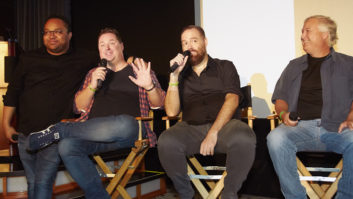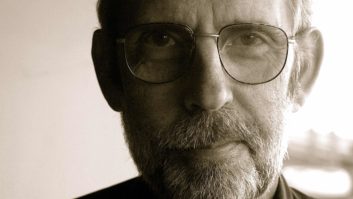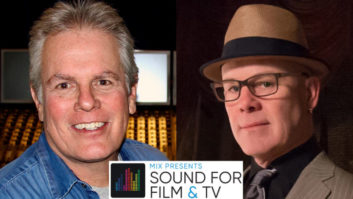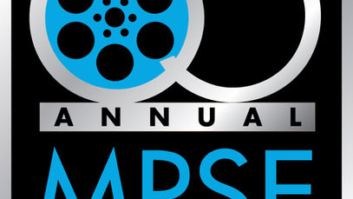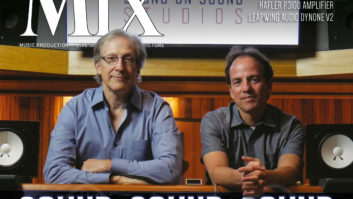It’s awards season for the film and television communities, and while much of the public attention is focused on the Oscars®, to be held March 4, with golden statues for Best Sound Editing and Best Sound Mixing, the rest of Hollywood focuses on the MPSE Golden Reel Awards and the Cinema Audio Society Awards. These two organizations, each with decades of support for the sound communities, will host their awards shows this month to honor the best in film and television sound.
MPSE GOLDEN REEL AWARDS
The 65th annual MPSE Golden Reel Awards will be held Friday, February 18, at the Westin Bonaventure in Los Angeles. Final voting ends on February 14. As part of the ceremony, the MPSE will honor sound recordist John Fasal with its Career Achievement Award, and director Katheryn Bigelow with its MPSE Filmmaker Award.
John Fasal

The Motion Picture Sound Editors will present Sound Designer and Sound Recordist John Paul Fasal with its 2018 MPSE Career Achievement Award. A 30-year veteran of the sound industry, Fasal has contributed to more than 150 motion pictures and is best known for his groundbreaking work in field recording. Among his many credits are Top Gun, Master and Commander: The Far Side of the World, Interstellar, The Dark Knight, American Sniper and this year’s box-office hit Dunkirk.
“John is a master of his craft, an innovator who has pioneered many new recording techniques, and a restless, creative spirit who will stop at nothing to capture the next great sound,” said MPSE President Tom McCarthy. “He is also an exceptional professional who enjoys the esteem of his colleagues in the sound world and filmmakers worldwide.”
The MPSE Career Achievement Award recognizes sound artists who have distinguished themselves as both an individual and fellow contributor to the art of sound for feature film, television and gaming, and for setting an example of excellence for others to follow. Fasal joins a distinguished list of sound innovators, including Harry Cohen, Richard King, John Roesch, Skip Lievsay, Randy Thom, Larry Singer, Walter Murch and George Watters II.
Fasal began his career as a musician and songwriter, but gravitated toward post-production sound in the 1980s. Among his first big successes was Top Gun, for which he recorded and designed many of the memorable jet aircraft sound effects. He has been a member of the sound teams on several films that have won Academy Awards in sound categories, including Inception, The Dark Knight, Letters from Iwo Jima, Master and Commander: The Far Side of the World, The Hunt for Red October and Pearl Harbor.
Fasal has worked as a sound designer and recordist throughout his career, but in recent years has increasingly focused on field recording. He enjoys especially high regard for his ability to capture the sounds of planes, ships, automobiles and military weaponry. “The equipment has changed dramatically over the course of my career, but the philosophy behind the craft remains the same,” he says. “It still involves the layering of sounds to create a sonic picture and help tell the story.”
Katheryn Bigelow
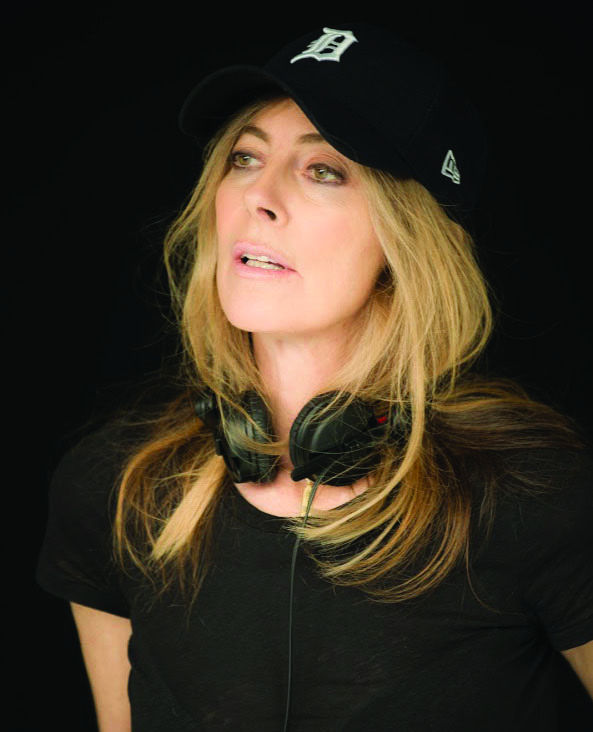
The director of such films as Detroit, Zero Dark Thirty and The Hurt Locker, Katheryn Bigelow is being recognized for her outstanding contributions to the art of cinema. A trailblazing filmmaker whose work is noteworthy for its emotional depth, arresting visuals and stunning action, Bigelow is the only woman to have won an Academy Award for Best Director, in 2010 for The Hurt Locker.
“Kathryn Bigelow’s films have that rare quality of challenging our preconceptions by moving us and creating moments of powerful empathy,” said MPSE President Tom McCarthy. “She is a true artist.”
Past recipients of the MPSE Filmmaker Award include Guillermo del Toro, Sam Raimi, Darren Aronofsky, George Lucas, Ang Lee, Michael Bay, Steven Spielberg, Brian Grazer and Gale Anne Hurd.
“Collaboration with the sound editor is a gratifying and inspiring time in the post process,” said Bigelow. “It is the moment that the film wraps itself around you, revealing its final form. I am honored to receive this award from my colleagues in sound editing.”
Bigelow studied painting at the San Francisco Art Institute. She later became interested in filmmaking and received a scholarship to Columbia University’s graduate film school. Her debut as a feature director came in 1982 with the drama The Loveless (co-written and co-directed by Monty Montgomery). That was followed by the features Near Dark (1987), Blue Steel (1989), Point Break (1991), Strange Days (1995), The Weight of Water (2000) and K-9: The Widowmaker, as well as several television projects.
The Iraq War drama The Hurt Locker (2008) won six Academy Awards, including Best Picture, Best Director, Best Original Screenplay, Best Editing, Best Sound Mixing and Best Sound Editing. Zero Dark Thirty, which followed in 2012, also achieved widespread critical and commercial success, and earned Best Director nominations from the Golden Globes and BAFTA, as well as an Oscar for Best Sound Editing. Her latest project, Detroit, is a deep and unsettling portrait of the race riots that gripped the Motor City in 1967.
CAS AWARDS
The 54th annual Cinema Audio Society Awards will be held Saturday, February 24, at the Omni Los Angeles Hotel. Final voting happens February 1-14. As part of the ceremony, the CAS will honor Tomlinson Holman, CAS, with its new Edward J. Greene Award for the Advancement of Sound. Re-recording mixer Anna Behlmer will receive the CAS Career Achievement Award.
Anna Behlmer, CAS
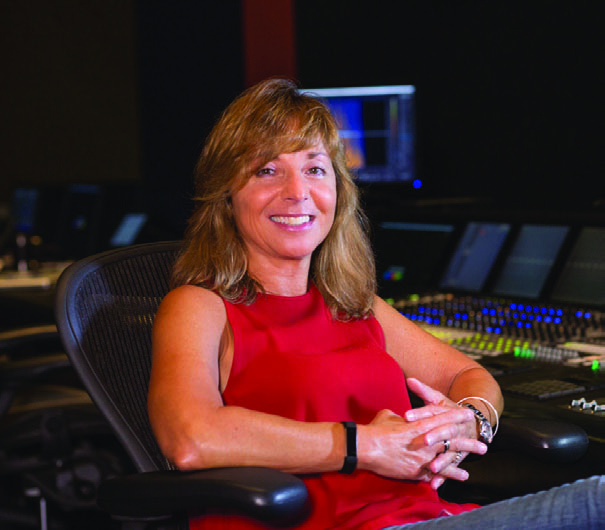
“It’s truly an honor to announce the selection of Anna Behlmer by the CAS for our Career Achievement award,” says CAS President Mark Ulano. “Her longtime collaborations with filmmakers and her work on over 150 projects is a testament to her excellence and creativity. She’s been nominated a dozen times for the prestigious CAS Award for her outstanding mixing work and is also multi-nominated by her peers at the Academy of Motion Pictures Arts and Sciences and the British Academy as well, signifying the very high regard with which she is held among her peers.”
Behlmer’s first call in the sound-for-picture business was on the Paramount lot, working on Laverne and Shirley and Happy Days as a Y-15 loader. She then went to work in the new Glen Glenn building on Stage 2, doing mostly TV and was promoted to recordist. Glen Glenn merged with Todd-AO and Behlmer joined the merged company’s new mixer training program. “I never looked back. I found something that was fun, that I loved doing and that I had an aptitude for,” said Behlmer.
In 1996, Behlmer became the first woman to be nominated for an Academy Award in the Sound Mixing category for Braveheart. The following year there was a second Oscar nomination for Evita. Behlmer moved over to Fox where she mixed for the next 14 years, adding eight more Oscar nominations for L.A. Confidential, The Thin Red Line, Moulin Rouge!, Seabiscuit, The Last Samurai, War of the Worlds, Blood Diamond and Star Trek. Additionally, she has received six BAFTA nominations (with three wins), 12 CAS nominations and five Satellite Award nominations.
In 2012 Behlmer became involved with the new Technicolor facility at Paramount. She now works about 50 feet from the place where she had her first call on Laverne and Shirley and Happy Days.
A longtime member of the Academy of Motion Picture Arts & Sciences, Behlmer has served several terms on the Sound Branch Executive Committee. She joins an illustrious group of past CAS Career Achievement Honorees that includes John Pritchett, Don Rogers, Walter Murch, Les Fresholtz, Tomlinson Holman, Richard Portman, Jim Webb, Charles Wilborn and Gary Rydstrom.
Tomlinson Holman, CAS

“The passing of Ed Greene had a profound effect on the CAS and sound community at large,” says CAS President Mark Ulano. “The Board of Directors and the former presidents wanted a meaningful way to honor Ed’s memory. So this award, in Ed’s name, to acknowledge the Advancement of Sound was created. Presenting this inaugural award to Tomlinson Holman, who has contributed so much to the sound community in both cinema and broadcast, is the perfect representation of who and what this award represents.”
It was during his college years at the University of Illinois that Holman began concentrating on sound during after-school activities in the theater department. His undergraduate film partner was director Andrew (Andy) Davis. After graduation, he stayed on at the university for five years in its film production unit. After a devastating fire, he got the post department up and running again.
Holman eventually bought a Nagra recorder and started doing projects, usually at the request of Davis, who ultimately asked Holman to move to Hollywood to work on a Blaxploitation feature, Cool Breeze, as a boom operator for first-time recordist Jeff Wexler.
A trip to Boston resulted in an interview and job with Advent in Cambridge, Mass. Founder Henry Kloss was occupied making tubes and screens for the first widely sold projection television, so he left the audio design part of the business to Holman. Later, Holman left to start Apt Corporation, which developed preamps and power amps.
As Chief Engineer of Post Production at Lucasfilm in Marin County, Calif., Holman was challenged to work on the ends of the chain that would be needed whether the general workflow was analog or digital: Holman evaluated developments in loudspeaker technology, invented some new technology, and then combined them into a system so impressive that George Lucas named the system THX: Holman’s initials and “X” to represent the critical crossover electronics Holman invented. With a companion Theater Alignment Program, THX standards included room acoustics and even projection standards, which created a standard presentation platform, deployed on a massive scale worldwide, upon which cinema audio professionals could rely.
After seven years full time at Lucasfilm, Holman started teaching at USC, while commuting to Skywalker Ranch weekly and working principally on THX and its spinoffs. In 1995 Holman left Lucasfilm to co-found TMH Corporation. Since then, he has manufactured products, edited a magazine, produced books and consulted on television’s transition to 5.1. He currently works at Apple.

